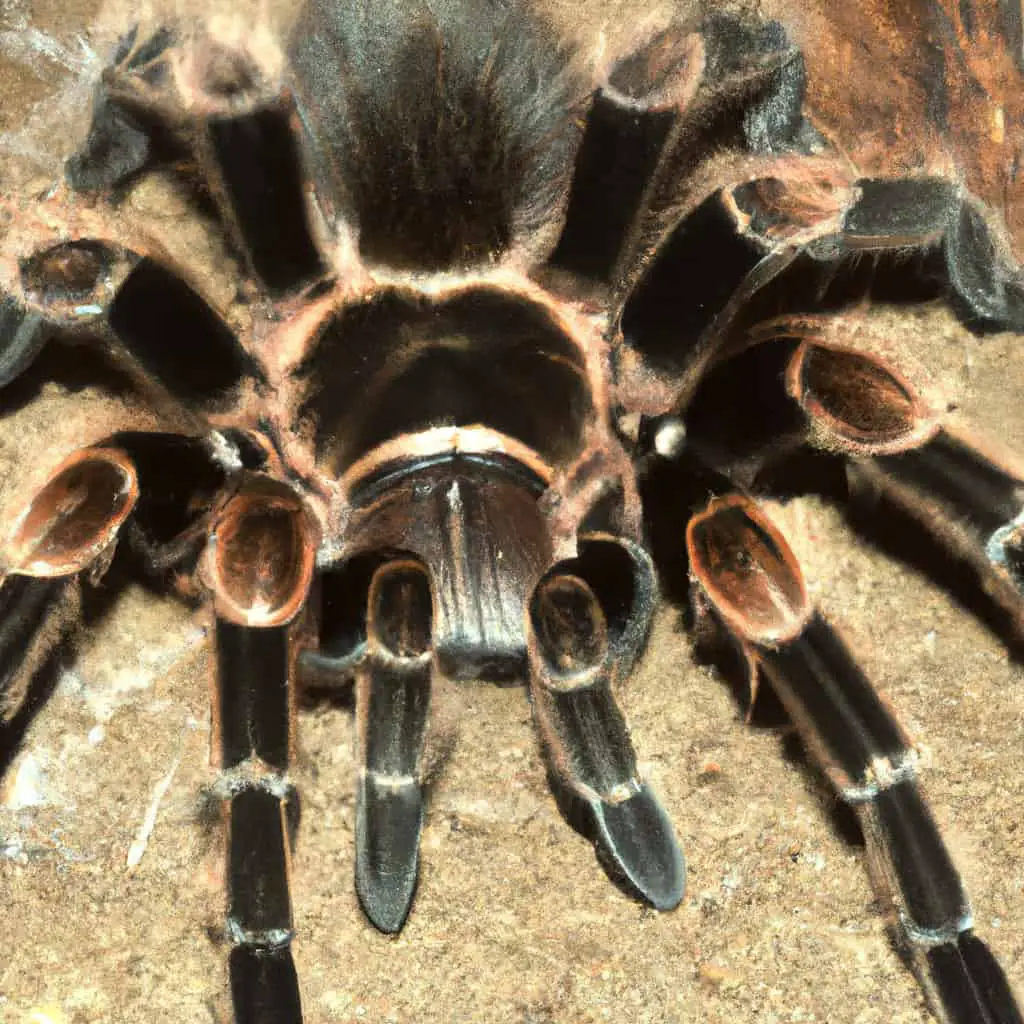As a tarantula owner, one of the most important aspects of caring for your pet is knowing when to feed them. Feeding your tarantula after molting is a crucial time as it can impact their health and well-being. But how long should you wait to feed your tarantula after a molt?
The answer depends on the age of your tarantula and their size. For spiderlings, they can be fed again sooner than adult tarantulas. Typically, for a sling, they only need one week between molting and food for their fangs to fully harden. Adults can require up to three weeks but generally, two weeks is the normal advice. However, it’s important to check your tarantula’s fangs before trying to feed them to ensure they are ready.
Key Takeaways
- Feeding your tarantula after molting is a crucial time for their health and well-being.
- The waiting period to feed your tarantula after molting depends on their age and size.
- It’s important to check your tarantula’s fangs before trying to feed them to ensure they are ready.

Understanding Tarantula Molting Process
Tarantulas molt to grow and repair their exoskeleton. It’s a natural process that occurs throughout their lives. As a tarantula owner, it’s essential to understand the molting process to ensure your pet’s health and safety. In this section, I will discuss the signs of molting and the different stages of the molting process.
Signs of Molting
Tarantulas exhibit several signs before and during molting. Knowing these signs can help you prepare for your pet’s molt and ensure they are safe during the process. Here are some common signs of molting:
- Loss of appetite
- Increased webbing activity
- Lethargy
- Darkening of the exoskeleton
- Bald spot on the abdomen
- Laying upside down
Molting Stages
The molting process consists of several stages, each with its unique characteristics. Here are the stages of the molting process:
- Premolt: This stage is when the tarantula prepares for molting. The tarantula may stop eating and become lethargic. The exoskeleton will darken, and the bald spot on the abdomen will become more prominent.
- Shedding: During this stage, the tarantula will shed its old exoskeleton. The tarantula will lay on its back and start to crack the old exoskeleton. The process can take anywhere from 15 minutes to 15 hours, depending on the tarantula’s age.
- Postmolt: After shedding the old exoskeleton, the tarantula will rest and wait for the new exoskeleton to harden. This stage can last anywhere from a few hours to several days. During this stage, the tarantula is vulnerable and should not be fed.
- Hardening: In this stage, the new exoskeleton hardens, and the tarantula’s coloration will become more vibrant. The tarantula will also start to eat again.
In conclusion, understanding the molting process is crucial for tarantula owners. By knowing the signs of molting and the different stages of the molting process, you can ensure your pet’s health and safety. Remember, during the postmolt stage, the tarantula is vulnerable and should not be fed.
Feeding Tarantulas Before and After Molting
As a tarantula owner, it is important to understand when and how to feed your pet. Feeding a tarantula before and after molting requires a bit of patience and attention to detail. In this section, I will cover the basics of feeding tarantulas before and after molting.
Decrease in Appetite Before Molting
One of the signs that a tarantula is about to molt is a decrease in appetite. As the tarantula prepares for molting, it will stop eating and become less active. This is because the tarantula’s body is focused on preparing for the molt, and it does not have the energy to hunt and eat.
If you notice that your tarantula is not eating as much as usual, it may be preparing to molt. It is important to stop feeding your tarantula at this point to avoid any complications during the molting process.
Feeding After Molt
After a tarantula has molted, it is important to wait before feeding it again. The tarantula’s exoskeleton is soft and vulnerable after molting, and it needs time to harden before it can eat again.
The amount of time you should wait before feeding your tarantula after molting depends on its age and size. Spiderlings can be fed again sooner than adult tarantulas. Typically for a sling, they only need 1 week between molting and food for their fangs to fully harden. Adults can require up to three weeks but generally, two weeks is the normal advice.
When you do feed your tarantula after molting, it is important to choose the right prey. Mealworms are a good option because they are soft-bodied and easy to digest. Make sure to remove any uneaten prey from the enclosure to avoid any health issues.
Waiting Period Post-Molting
As a tarantula owner, it’s important to know the right time to feed your freshly molted tarantula. Feeding too early can be detrimental to their health, while waiting too long can lead to dehydration and starvation. In this section, I will discuss the waiting period post-molting and the importance of hydration and understanding the hardening process.
Importance of Hydration
Hydration is crucial for tarantulas, especially after molting. The exoskeleton is made up of chitin, which is a polymer of N-acetylglucosamine. This polymer requires water to harden properly. Therefore, it’s important to ensure that your tarantula has access to fresh water at all times.
During the waiting period post-molting, it’s important to mist the enclosure to increase the humidity levels. This will help prevent the exoskeleton from drying out and cracking. Additionally, providing a shallow water dish can help your tarantula rehydrate after molting.
Understanding the Hardening Process
After molting, tarantulas need time to harden up their new exoskeleton. This process can take anywhere from a few days to a few weeks, depending on the age and species of your tarantula.
For younger tarantulas, such as spiderlings, the fangs harden faster than adult tarantulas. Typically, spiderlings only need one week between molting and food for their fangs to fully harden. Adults can require up to three weeks, but generally, two weeks is the normal advice.
It’s important to check your tarantula’s fangs before trying to feed them. If the fangs are black, it’s a good sign that they are ready to eat. However, if they are still pink or white, it’s best to wait a few more days before attempting to feed them.
Special Care for Vulnerable Tarantulas
As a tarantula owner, it’s important to know the right time to feed your pet after a molt. However, it’s equally important to know how to care for your tarantula during this vulnerable time. In this section, I will cover the special care that vulnerable tarantulas need after a molt.
Caring for Slings
Slings or young tarantulas are more fragile than adult tarantulas and require special care after molting. It’s important to wait until the fangs of your sling have hardened before feeding them. This usually takes around 3-5 days. Trying to feed them before their fangs have hardened can lead to injury or even death. Additionally, slings should be given smaller prey items compared to adult tarantulas.
After molting, slings should be kept in a warm and humid environment to help them harden their exoskeleton. They should also be given plenty of rest and not disturbed too much. It’s important to monitor your sling closely during this time and make sure they are eating and drinking.
Adult Tarantulas Care
Adult tarantulas are less vulnerable than slings, but they still require special care after molting. It’s generally recommended to wait at least 10 days before feeding an adult tarantula after molting. However, it’s always best to check their fangs before feeding them. If their fangs are still soft or not fully black, it’s best to wait a few more days before feeding them.
During this time, adult tarantulas should also be kept in a warm and humid environment. They should be given plenty of rest and not disturbed too much. It’s important to monitor your adult tarantula closely during this time and make sure they are eating and drinking.
Common Concerns and Solutions
Dealing with Dehydration
One of the most common concerns after a tarantula molts is dehydration. It’s important to make sure your tarantula has access to fresh water at all times, but especially after molting. A dehydrated tarantula may appear lethargic, have sunken eyes, and have dry, wrinkled skin.
To prevent dehydration, make sure to mist the enclosure lightly with water and provide a shallow dish of fresh water. You can also offer a piece of fruit or vegetable to increase the moisture content in their diet.
If you suspect your tarantula is dehydrated, you can try offering a small amount of water on a paintbrush or dropper. Make sure the water is room temperature and not too cold.
Addressing Decrease in Activity
After molting, tarantulas may be less active than usual. This is because they are still recovering and their new exoskeleton is still hardening. It’s important to give them time to rest and recover.
However, if you notice a significant decrease in activity or your tarantula has not eaten in several weeks, there may be cause for concern. Check the temperature and humidity levels in the enclosure to make sure they are within the appropriate range for your species of tarantula.
If everything seems to be in order, try offering a smaller prey item or a different type of food. Some tarantulas may be picky eaters and prefer certain types of prey.
Remember to be patient and give your tarantula time to adjust after molting. With proper care and attention, they should return to their normal activity levels in no time.
Tarantula Enclosure Management
As a tarantula owner, it is important to understand the proper management of their enclosure. This includes the substrate used, the webbing that tarantulas produce, and the timing of feeding after molting.
Importance of Substrate
The substrate used in a tarantula’s enclosure is crucial to their health and well-being. It should be chosen carefully to ensure that it is safe and provides a suitable environment for the tarantula.
One popular substrate is coconut fiber, which is natural and holds moisture well. It is also easy to clean and replace when necessary. Another option is vermiculite, which is lightweight and helps to regulate humidity levels in the enclosure.
It is important to avoid using substrates such as sand or gravel, as they can cause injury to the tarantula and can be difficult to clean.
Understanding Tarantula Webbing
Tarantulas are known for their ability to produce webbing, which they use for a variety of purposes. This includes creating a safe place to molt, catching prey, and creating a barrier to protect their territory.
It is important to understand the role that webbing plays in a tarantula’s life and to avoid disturbing it unnecessarily. If you need to clean the enclosure, try to avoid disturbing the webbing as much as possible.
Feeding After Molting
After a tarantula molts, it is important to wait before feeding them again. This is because the tarantula is weak and vulnerable during this time, and may not be able to eat properly.
Typically, it is recommended to wait at least a week before feeding the tarantula again. This allows their fangs to fully harden and ensures that they are strong enough to eat.
Community Insights
When it comes to caring for tarantulas, the community can be a great resource for information. Many forums and chat groups exist where tarantula owners can share their experiences and ask for advice.
One common question that comes up is how long to wait before feeding a tarantula after it has molted. While there is no one-size-fits-all answer, the general consensus among experienced tarantula owners is to wait until the tarantula’s fangs have hardened and turned black before offering food. This can take anywhere from a few days to a few weeks, depending on the species and age of the tarantula.
It’s important to note that not all tarantulas will behave the same way after molting. Some may be eager to eat right away, while others may fast for weeks or even months. As a tarantula owner, it’s important to be patient and observe your pet’s behavior to determine when it is ready to eat.
If you’re new to tarantula ownership and have questions about feeding after molting, don’t be afraid to reach out to the community for advice. Just be sure to take any advice with a grain of salt and do your own research to ensure that it is accurate and up-to-date.
Finally, it’s worth noting that some older forums and websites may have out-of-date information on tarantula care. If you come across conflicting advice, try using an alternative browser or checking more recent sources to ensure that you are getting the most accurate information.
Insects as Prey
When it comes to feeding tarantulas, insects are the primary source of food. Tarantulas are known to feed on a variety of insects, including crickets, grasshoppers, and roaches. These insects are readily available at most pet stores and are relatively easy to care for.
One important thing to keep in mind is that tarantulas require live prey. They will not eat dead insects, so it’s important to make sure that the insects you feed your tarantula are alive and healthy.
Crickets are one of the most popular insects to feed tarantulas. They are readily available at most pet stores and are relatively easy to care for. However, it’s important to make sure that the crickets you feed your tarantula are the right size. Tarantulas can be injured or even killed by crickets that are too large.
Grasshoppers are another popular insect to feed tarantulas. They are larger than crickets and can provide a more substantial meal for your tarantula. However, they can be more difficult to find and care for than crickets.
When feeding your tarantula, it’s important to make sure that the insects you feed them are healthy. Sick or diseased insects can make your tarantula sick, so it’s important to inspect each insect before feeding it to your tarantula.
Tarantula Guide
As a tarantula owner, it’s essential to know how long to wait before feeding your pet after it molts. The time it takes for a tarantula to be ready for food after a molt varies depending on several factors, including size, behavior, and damage. In this guide, I will provide you with all the necessary information you need to know about feeding your tarantula after it molts.
Size Matters
The size of your tarantula plays a significant role in determining how long you should wait before feeding it after a molt. Spiderlings, for example, can be fed sooner than adult tarantulas. Typically, a spiderling only needs one week between molting and food for their fangs to harden fully. Adults, on the other hand, can require up to three weeks, but generally, two weeks is the normal advice.
Behavior and Damage
It’s crucial to observe your tarantula’s behavior and check for any damage after it molts. If your tarantula is hiding, it’s probably not ready for food yet. You can also tell if your tarantula is ready for food by checking the color of its fangs. If the fangs are black, it indicates that they are ready for food. If the fangs are still white, it’s best to wait a little longer.
Feeding Spiderlings
When feeding spiderlings, it’s important to remember that they are fragile and can be easily injured. Therefore, it’s best to feed them small prey, such as fruit flies or pinhead crickets. Overfeeding spiderlings can lead to health problems, so it’s crucial to monitor their feeding habits closely.
Feeding Adult Tarantulas
Adult tarantulas are less fragile than spiderlings, but it’s still essential to feed them the right prey size. Feeding them larger prey can lead to health problems, such as constipation or impaction. It’s best to feed adult tarantulas prey that is no more than half their body size.
Conclusion
Feeding your tarantula after it molts is crucial for its health and wellbeing. By following the guidelines in this guide, you can ensure that your tarantula is fed at the right time and with the right prey size. Remember to observe your tarantula’s behavior and check for any damage before feeding it. With these tips, you can provide your tarantula with the best care possible.
Frequently Asked Questions
How long after molting can I feed my tarantula?
It is generally recommended to wait at least a week before feeding your tarantula after molting. However, the exact amount of time can vary based on the species and age of your tarantula. Adult tarantulas can require up to three weeks, but generally, two weeks is the normal advice. If you’re uncertain about how long to wait to feed your tarantula, there’s no harm in giving it another week just to be safe.
Why won’t my tarantula eat after molting?
After molting, tarantulas can be weak and vulnerable. They may not feel comfortable eating until their exoskeleton hardens. Additionally, their fangs may still be soft and not fully functional, making it difficult for them to eat. If your tarantula is not eating after molting, don’t worry, it’s normal. Just wait a little longer before trying to feed it again.
Do tarantulas eat their molt?
Yes, tarantulas will often eat their molted exoskeleton. This provides them with valuable nutrients, including protein and chitin, which helps harden their new exoskeleton. However, not all tarantulas will eat their molt, and some may only eat certain parts of it.
How long does it take a tarantula to molt?
The time it takes for a tarantula to molt can vary based on the species and age of your tarantula. Generally, it takes a few hours for the actual molting process, but the entire process can take several days. During this time, your tarantula will be vulnerable and should not be handled or disturbed.
When should I handle my tarantula after molting?
It is best to wait at least a week before handling your tarantula after molting. During this time, your tarantula’s exoskeleton will harden, and its fangs will become fully functional. Handling your tarantula too soon after molting can cause stress and even lead to injury.
Can I touch my tarantula after molting?
It is not recommended to touch your tarantula after molting. During this time, your tarantula is vulnerable and may be more aggressive than usual. Additionally, touching your tarantula can transfer oils and bacteria from your skin, which can be harmful to your tarantula’s health.








